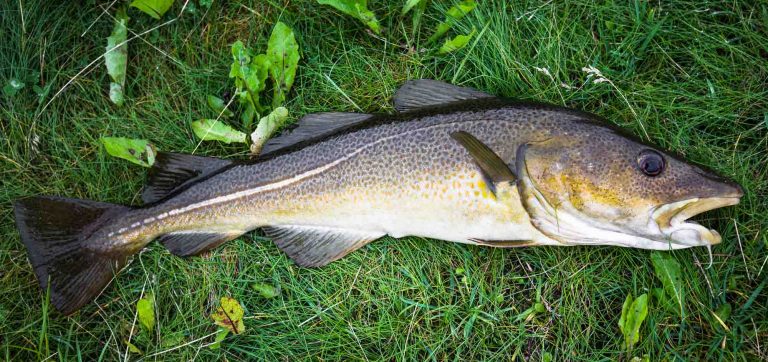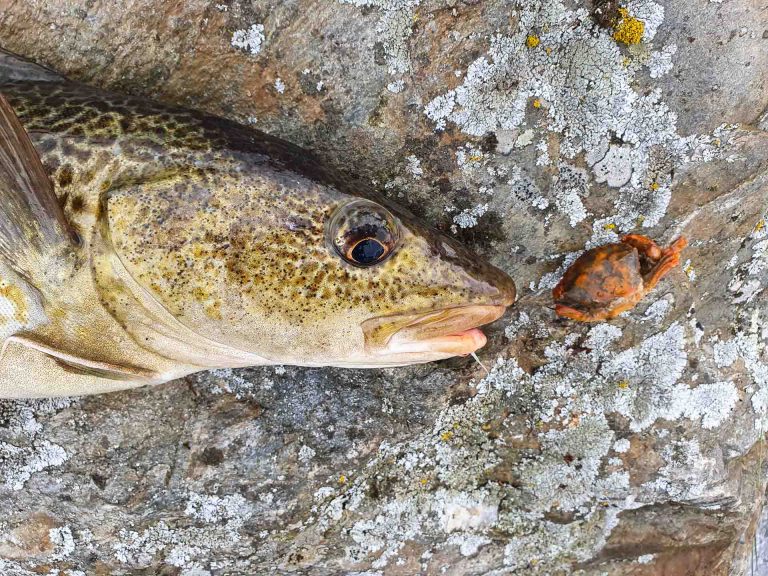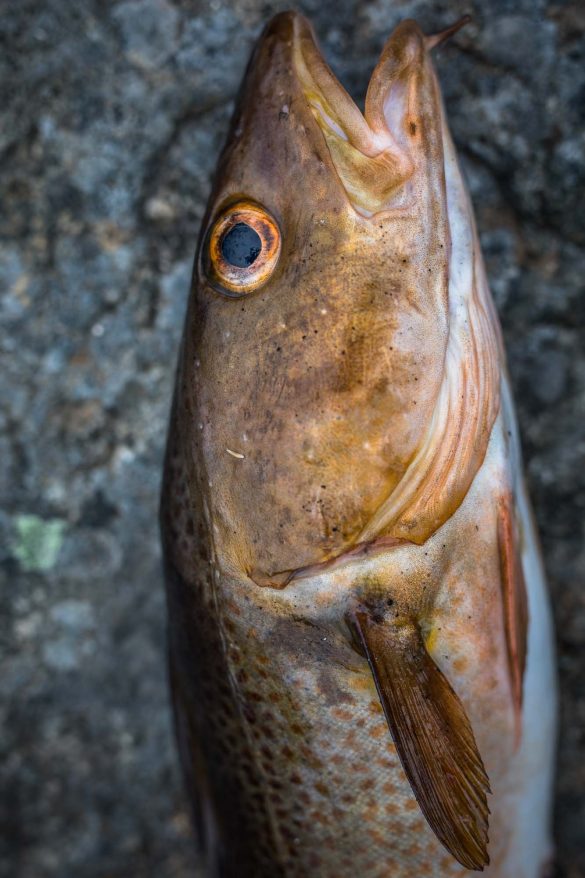(nor.: torsk, swe.: torsk; fin.: turska; dt.: Dorsch)

Cod fishing has been going on along the coast of Norway since thousands of years. Dried cod was used on long voyages by the vikings and one of their first trading goods. Norwegians exported dried cod to southern Europe, primarily Spain and Italy since the Viking ages. Exports have been uninterrupted for more than 1000 years and are still of great importance. The world famous stockfish is primarily produced in Lofoten, where commercial and recreational fishing for the spawning Atlantic cod takes place at the beginning of each year. If you travel around the northern coastal parts of Norway from the Lofoten upwards you will encounter huge wooden frames full with more or less dried cod in many places.
Cod can grow up to 2 m long and weigh up to 60 kg. Its characteristic “chin beared” is actually a fin. The main spawning season for cod is ussually in March and April. That’s also the time when commercial and recreational fishing for cod is at it’s peak. And yes, Norway is the place to be when it comes to codfishing, especialy the area from Lofoten up to Tromsø

Fishing and Fishing Methods
The great thing about cod fishing along the Scandinavian coast is, that you can catch them from shore as well as from a boat. Although, larger specimen and trophy fish are caught from boat, one can also find decent sized cod that make for a god dinner along the coastline.
Best times for fishing big specimen is March to April when the weather gets calmer and large schools of cod can be found on the outer coastline of Norway. That said, smaller but still decend-sized specimen can be caught whole year round. Depending on the fishing method, best times for cod fishing is ususally early morning.
When fishing inshore look out for areas with dense rocks, cliffs or even some kelp with good hiding places. When it comes to jig- and bait size, bigger is definitely better. Cod hunt close to the bottom and heavy jigs definitely help to get your lure down to these depths. When fishing with bait, hering or makarel are a good way to go. However, shrimp, squid or mussels are great too but make sure to use enough or otherwise you’ll end up with small specimen.
Regarding equipment you are usually best of with a spinning rod in the medium range when inshore fishing. The range of around 50g will do just fine if you are fishing for smaller specimen. Otherwise you might look for something in the 50 to 150 gram range. A braided mainline 20 to 30 lb (10 to 15 kg) will do for most purposes. However if you intend to tackle bigger fish you have to consider more heavy equipment.
When it comes to lures our first choice are rubber sheds in the range from 50 to 150 grams. These lures are very versatile and despite cod you can catch big coal fish or if extremely lucky even a halibut.
Spinning
- Sheds (50 – 200 grams)
- Jigs (50 – 200 grams)
- Jigs (boat) (200 – 500 grams)
- Pilk (50 – 200 grams)
Angling
- Herring
- Smelt
- Mackerel
- Peeler Crab
- Rag worm
- Lug worm
- Squid
Angling Record
- Finland: N/A
- Sweden: N/A
- Norway: 38 kg

Appearance
The main differences that distinct cod from other fish are the three dorsal and two stern fins. Depending on zhe habitat the coloring of cod can vary – fish living in shallow coastal waters are usually greenish to brownish, while cod living in deep-water areas are generally more greyish in color.
Occurrence and origin
Cod can be found all along the Scandinavian and Finnish coastline. There are two different population of cod coexisting in the Arctic waters: the coastal cod and the Arctic cod. As the name suggests, the coastal cod spends its entire life in shallow waters close to the cost. However, its close relativ migrate to the Arctic waters of the North for most part of its life. Occasionaly they return to their spawning grounds in northern Norway and do so in huge numbers. These fish build the cornerstone of the Norwegian fishing industry. Spawning season takes place in winter which makes the fishing season challanging and short. However, since their journey is physically demanding they feature well trained muscles and are considered superior to their coastal dwelling relatives.
Some of the most famous cod grounds for recreational as well as commercial fishing are the waters arround the Lofoten islands. Every year the world cod fishing chamnpionship takes place in Svolvaer in Lofoten where the biggest cods in the world are drilled.
Also noteworthy is that there are two separate cod stocks in the Baltic Sea with different spawning grounds. The boundaries of these cod stocks are not clear and mixing occurs regularly. On the Finnish coast, cod is found in the sea area between Kotka and Kvarken. However, if you are serious about cod fishing there is no way arround the Norwegian waters.
Increase
Cod increase in the depths of the Baltic Sea far from Finnish territorial waters. Successful reproduction requires a salinity of at least 10-11 per cent, as lower fertilized eggs sink to the bottom and do not develop into chicks. Oxygen is also much needed and mixes with salt water all the way to the bottom only when a large pulse of salt attacks through the Danish straits into the Baltic Sea. Unfavorable salinity and oxygen conditions in the Baltic Sea currently limit the growth of cod.
Nutrition, growth and hiking
Atlantic cod can weigh in at heavy numbers and 30 kg specimen are frequently reported.
The weight of cod found in the Baltic coastal areas usually varies from about half a kilo to five kilos. After salmon, Atlantic cod is one of the fastest growing fish species. 2-year-old cod weigh in arround 1,5 kg, 5-year-olds can weigh over 10kg and from there numbers grow only further. They can get 20 years old. The actual world record for a hand reeled cod is actualy set by a woman – the swede Marica Eriksson who reeeled in a cod weighing 38 kilos (83,5 lb) outside the island of Sørøya in Norway.
Adult cod migrate long distances during the growing season in search of food. During the spawning season, they congregate in large flocks in the shallower waters. Cod come to spawning grounds even after long trips. Even in the Baltic Sea, cod have been found to migrate up to 1,000 km. Cod are very powerful and fast swimmer. They feed on herring and other fish, but squid and other invertebrates can also be on the menu.
Strain threats, management and endangerment
Cod are economically the most important fish in the world and almost all cod stocks are also being exploited to the maximum. Cod fishing has been regulated in Norway since the 1970s. Modern regulation is justified on the basis of the risk of overfishing and unreasonable taxation. In the Baltic Sea cod fishery has unfortunately been so efficient that it has affected the spawning stock and increased the likelihood of an endangered cod population. Poor water quality in spawning grounds makes it difficult for stocks to recover, as successful reproduction requires better oxygen conditions and sufficient salinity.
Data on this site
Data on this site was derived from various sources amongst others LUKE database.
